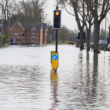Redefining ‘a shot in the dark’
In December 1999, the Department of Public Safety (DPS) in Highland Park, Texas, completed a project testing thermal imaging cameras and their effectiveness in aiding law enforcement. The agency was one of 13 in the Dallas-Grayson corridor that participated in the year-long study, which was designed to measure the impact of thermal imaging on a single metropolitan area.
First developed for military use, infrared thermal imaging cameras – also called forward-looking infrared cameras – do not require light for effective operation. They measure relative temperature differences and convert the heat patterns into clear images, allowing the user to see all objects in the camera’s field of view.
Sponsored by Dallas-based Raytheon Commercial Infrared and the National Institute of Justice (NIJ, the research and development arm of the U.S. Department of Justice), the Dallas-Grayson study involved a broad range of applications for the technology. For example, public safety agencies used thermal imaging during search and rescue missions; marine, ground and perimeter surveillance; vehicle pursuit; structure profiling; and more.
With $1 million from the sponsors, the participating cities purchased the cameras and obtained the necessary training for the study. Highland Park bought a hand-held camera, as well as two cameras that could be mounted on police cars.
The technology was used on all patrols, says Capt. Bobby Richardson of Highland Park’s DPS. “It’s like having an additional officer out in the field,” he explains. “It’s an unobtrusive way to search a neighborhood for fleeing suspects. It doesn’t alarm homeowners like a spotlight shining on their homes, nor does it give away the officer’s position to a suspect.”
It does reveal the location of suspects, cars and evidence, however. “We tracked a suspect in a building from footprints and handprints visible only through the thermal imager,” Richardson says. “We thought we had lost him, but, by scanning the room, we found a hot spot in the ceiling. If we didn’t have the thermal imager, we probably wouldn’t have been able to locate him.”
Other participants in the study found similar advantages in using the technology. For example, Lt. Mark Hudson of the Grayson County Sheriff’s Office notes that thermal imaging assists officers in seeing whether suspects are armed. He says it also is valuable to officers patrolling rural roads, helping them avoid livestock and other road hazards.
“We used the infrared camera at accident scenes for more accurate measurements of skid marks,” adds Detective Larry Wilson of Plano, Texas, another study participant. “We’ve also used it to assist officers in gathering evidence and to uncover situations of evidence tampering. Blood on a wall or floor that has been cleaned up still leaves characteristics that can be viewed with a thermal imager.”
The NIJ analyzed the Dallas-Grayson data in 2000, and it plans to release the results this year. For more information, visit the institute’s Web site at www.ojp.usdoj.gov/nij.



















